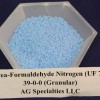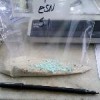 In response to the Federal Clean Water Act of 1972 and the Florida Restoration Act of 1999, a series of best management practices (BMPs) was implemented to improve surface and ground water quality. BMPs are cultural practices that, when implemented as a plan, help reduce the environmental impact of production while maintaining yield and quality. One of these BMPs includes the use of controlled-release fertilizer, which is an enhanced-efficiency fertilizer. This publication describes the common enhanced-efficiency fertilizers and the factors affecting their use in Florida vegetable production. This 9-page fact sheet was written by Luther Carson and Monica Ozores-Hampton, and published by the UF Department of Horticultural Sciences, October 2014.
In response to the Federal Clean Water Act of 1972 and the Florida Restoration Act of 1999, a series of best management practices (BMPs) was implemented to improve surface and ground water quality. BMPs are cultural practices that, when implemented as a plan, help reduce the environmental impact of production while maintaining yield and quality. One of these BMPs includes the use of controlled-release fertilizer, which is an enhanced-efficiency fertilizer. This publication describes the common enhanced-efficiency fertilizers and the factors affecting their use in Florida vegetable production. This 9-page fact sheet was written by Luther Carson and Monica Ozores-Hampton, and published by the UF Department of Horticultural Sciences, October 2014.
http://edis.ifas.ufl.edu/hs1247
Tag: Luther C. Carson
Methods for Measuring Controlled-Release Fertilizer Nitrogen Release Used for Vegetable Production
 Enhanced-efficiency fertilizers are a group of fertilizers that reduce the risk of nutrient loss to the environment and subsequently increase fertilizer use efficiency. This increase may be accomplished through maintaining nutrients in the root zone by physical barriers, reduced solubility, or retaining nutrients in a less leachable form. This 7-page fact sheet examines laboratory, growth chamber, greenhouse, and field methods for measuring nitrogen release in controlled-release fertilizers. Written by Monica Ozores-Hampton and Luther C. Carson, and published by the UF Department of Horticultural Sciences, August 2013.
Enhanced-efficiency fertilizers are a group of fertilizers that reduce the risk of nutrient loss to the environment and subsequently increase fertilizer use efficiency. This increase may be accomplished through maintaining nutrients in the root zone by physical barriers, reduced solubility, or retaining nutrients in a less leachable form. This 7-page fact sheet examines laboratory, growth chamber, greenhouse, and field methods for measuring nitrogen release in controlled-release fertilizers. Written by Monica Ozores-Hampton and Luther C. Carson, and published by the UF Department of Horticultural Sciences, August 2013.
http://edis.ifas.ufl.edu/hs1227